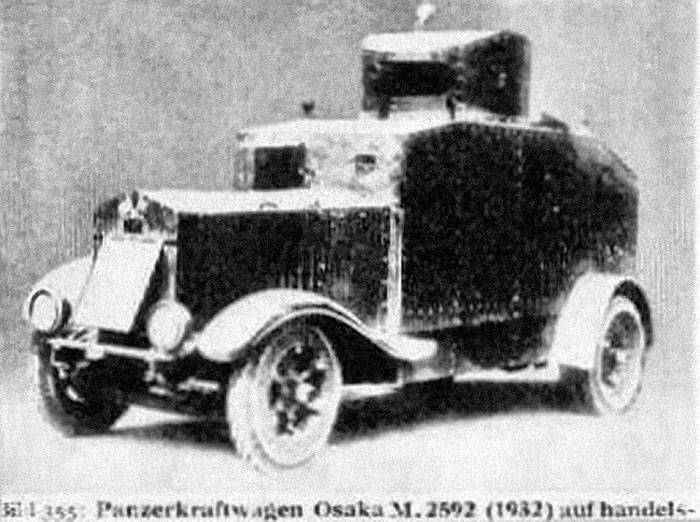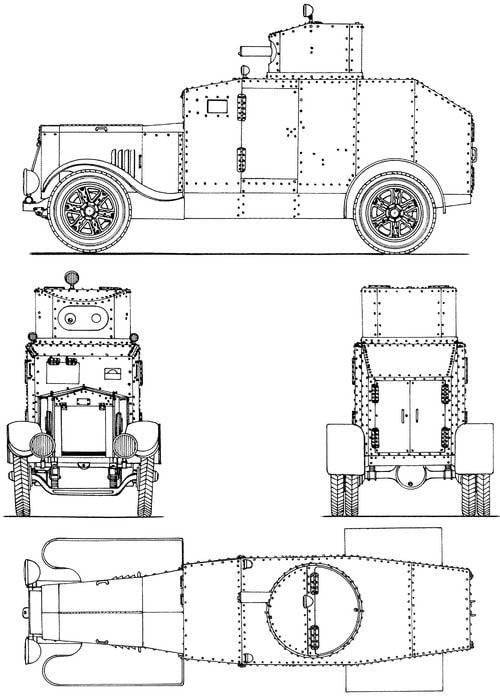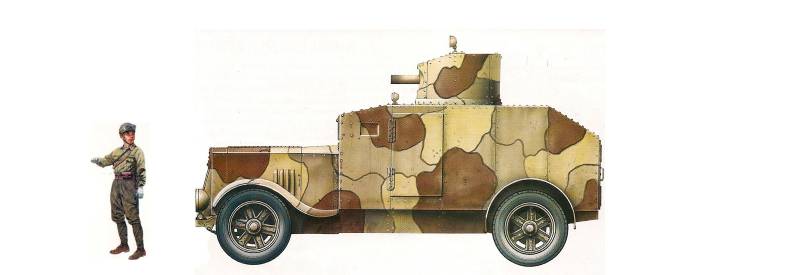Armored car "Type 92" / "Osaka" (Japan)
Unfortunately, much of the early stories Japanese armored vehicles covered in darkness. Many details of the history of the first armored cars and other vehicles simply did not survive or are waiting in the wings in the archives. One of the "victims" of such circumstances was the armored car "Type 92", created in the early thirties. Lack of information, as well as some problems with access to it for a long time led to a specific situation. There is not much information about Osaka, and some of the data contradict each other. In addition, the fact that several armored vehicles under the name "Type 1932" were adopted at once in the 92 was a significant confusion.
Apparently, the main prerequisite for the appearance of the armored car "Type 92" / "Osaka" was a fundamental decision of the command of the Japanese Imperial Army to create a number of new combat vehicles. Having tested a number of existing armored cars at the test sites, the military leaders understood all the prospects of such equipment. As a result, at the very beginning of the 1930s, a program was launched, within which several enterprises of the automotive and defense industry of Japan tried their hand.

General view of the armored car "Type 92" / "Osaka". Photos of Tanks-encyclopedia.com
It is believed that the next project of an armored car was proposed by Osaka Arsenal specialists. It is with this circumstance that one of the names of the car is called “Osaka”. Later, having got into the army, the armored car was named “Type 92” or “Type 2592”, which indicated the year of its commissioning according to the Japanese calendar. In addition, in the context of the project, additional names “Hokoku-Go” and “Aikoku” are mentioned - by the name of political organizations that, according to one of the versions, could finance design work and construction.
Experts from Osaka, as well as their colleagues from other companies, decided to use the easiest and most convenient way to build an armored car. They took the existing serial car chassis with suitable characteristics and installed on it the armor case of the desired configuration. It is noteworthy that the project of the future "Type 92" did not envisage some changes characteristic of other developments of this kind. In particular, the designers refused to replace the wheels with new products of reinforced construction.
According to reports, the basis for the Osaka armored car was a commercial truck chassis with a lifting capacity of 2,5 t, which had the wheel formula 4 х2. The chassis had a traditional frame structure with a bonnet layout, which provided for the front installation of the engine and gearbox. Some sources mention the possible use of all-wheel drive cars. According to various sources, the car was completed with a British-made Wolseley carburetor engine. Power - 35 or 45 HP In any case, regardless of its type and power, the engine was connected to a mechanical transmission.
Four wheels were installed on two axles with a dependent suspension, which included "classic" leaf springs. The front axle had controls and was equipped with single wheels. Rear leading axle was completed duo-pitch. It is curious that when creating their armored car, Arsenal Osaki did not use the wheels of a new design. The basic truck borrowed wheels with large-width spokes and pneumatic tires. Also from the existing project took the wheel wings. The front had a complex curved shape, while the wheels of the rear axle were covered with simple semi-circular details.
An original armor hull was developed that corresponded to the basic ideas of its time. Its basis was a skeleton of metal profiles, on top of which armor plates of the required configuration were fixed on rivets and bolts. The thickness of the armor, according to various sources, was within 8-11 mm. This made it possible to protect the machine from fire weapons. In addition, she could withstand the hit of fragments of artillery shells. The building was built according to the traditional layout - the front part, which had smaller dimensions, was designed to protect the engine. Inhabited compartment was larger.
The frame and running gear of the Osaka had limited protection. Long rectangular plates of small height covered only the side portions of the frame, between the axes. At the same time, there was no protection of the frame in front and behind.
The armored car got a fairly simple design hood. The front of the engine was protected by a sloping frontal sheet with a large opening, over which the rocking cover was mounted. With the help of the latter, it was possible to regulate the access of air to the radiator, while maintaining acceptable protection. The hull sides diverged in the rear, and in the case of their rear elements this angle increased. The bonnet roof consisted of a pair of sloping sheets, also hatch covers for maintenance. On the sides of the radiator were lights. It is noteworthy that the protection of these devices was absent.
Behind the extended rear of the hood was a large frontal sheet. Above the hood rose his site with viewing devices. On the sides of the hood, there were small rectangular projections. The front of the habitable compartment, which served as the control compartment, was expanded at the rear. Behind it were vertical sides, also installed at an angle to the longitudinal axis of the machine. The hull feed, in turn, had a pair of converging sides. Above the control post there was a forward tilted armor plate, behind which a horizontal detail of large dimensions was provided. The hull feed was also equipped with a sloping roof.

Scheme of the car. Figure Tanks-encyclopedia.com
On the horizontal part of the roof was placed a cylindrical tower, assembled on the basis of the frame. The forehead, sides and stern of the tower were a single surface. Frontal sheet had a large opening in which there was a straight part with seats for weapons and means of observation. The roof of the tower consisted of two parts. The front was mounted with a slope forward, the rear - horizontally. According to some information, the rear element of the roof was a movable hatch cover or had an opening for its installation.
Osaka armored car could carry relatively powerful weapons in the form of two 3 Type machine guns or other rifle-caliber systems. In the case of the “Type 3” machine guns, the crew could fire at a rate of up to 400-450 rounds per minute. The combat feeding of such machine guns was carried out using special rigid tape cassettes on 30 cartridges. Spare cassettes were placed on shelves of habitable compartments.
According to others, the armored vehicle carried two machine guns "Type 91". This weapon had similar firing characteristics and used a similar cartridge. The main difference between the two machine guns was in the way of ammunition. "Type 91" instead of rigid tape cassettes used bunker shop.
One of the machine guns of the 2592 Type armored car was mounted on a ball mount in the frontal part of the turret, with a shift to the right from the longitudinal axis. Turning the tower provided a circular alignment horizontally. The ball system made it possible to swing a weapon in a vertical plane, as well as to perform a fine tip in a horizontal plane. The front sheet of the habitable compartment was equipped with a second machine-gun installation, which allowed shelling targets in a limited sector of the front hemisphere.
The car should have been driven by a crew of at least three people. In this case, the driver and two arrows were located inside the armored hull. The control post with the driver’s workplace was located in the front right part of the compartment. To his left was the shooter. A relatively large access hatch (on the right) for the driver was provided for in the front plate. In a combat situation, it was closed, after which it was necessary to follow the road through the existing gap. In place of the shooter there was a flap with attachments for the machine gun. In the zygomatic sheets of the hull there were additional hatches smaller. In the fighting compartment, directly under the tower, the second shooter was supposed to work. He also had the means of observation. The presence of a hatch in the roof of the tower to some extent improved the view.
According to known data, the body of the armored car received several doors. Two of them were in the boards, directly behind the jobs of the driver and the shooter. The hull's stern sheet was actually a frame with a large opening in the center. The latter was closed by a hinged double door. This door provided easy access to the fighting compartment.
In some sources are given the overall and weight characteristics of the armored vehicle "Type 92" / "Osaka". It is alleged that this machine had a length of 5 m with a width of less than 1,9 m and a height of about 2,8 m. The combat weight could reach 5,5-5,85 t (according to other data, up to 6,4 t). 35 or 45 hp engine allowed the armored car to reach the highway speed to 60 km / h. Reverse speed does not exceed 6-6,5 km / h. Cruising reached 240 km. The machine could overcome certain obstacles, but its permeability and other characteristics on rough terrain could hardly be called outstanding.
The design of the armored vehicle “Type 92” was developed in 1930-32. Soon Osaka Arsenal built the first car of this model. Known information suggests that it was tested, the results of which the military made their decision. Apparently, such a decision was not positive, in favor of which other known information speaks. However, in the history of Japanese armored vehicles, the Osaka machine remained under the name, marking the adoption of the 1932 in service year.
Exact information about the release of machines "Type 2592" missing. According to some information, only one prototype was built, while other sources claim that the armored car was built in a large series. According to these data, for several years, Japanese industry has built about 500 armored vehicles. There is reason to believe that the latest version does not fully correspond to reality. Five hundred armored vehicles could certainly have left a noticeable mark on the history of hostilities, but this did not happen. Thus, Osaka armored cars - even if they reached mass production - were not produced in noticeable quantities.
More popular is the alternative version, which is more believable. It involves the construction of one or more armored vehicles required for testing. The prototype / prototypes passed the necessary checks, after which the military decided not to adopt such equipment and not to launch its mass production. The armored car turned out to be a technology demonstrator, and not the most successful one. The absence of serious advantages in the presence of certain disadvantages seriously limited the prospects for the machine.
The Osaka armored car differed in its specific appearance and characteristics at the level of the early Japanese samples of its class. It is possible that the military machine was considered unserviceable because it was outdated by the time it appeared. Thus, the project had no future. An experienced armored car or armored cars would soon have to be dismantled as useless. The future of the fleet of armored vehicles of the Imperial Japanese Army was behind other models.
In the early thirties, having received the assignment of the military department, the Japanese industry launched the development of several promising armored cars. Some of them were soon put into service and put into series, while others did not go beyond the limits of the landfills. Known data indicates that the 92 / Osaka type machine belongs to the latter. A mature design approach has imposed certain restrictions on the final project result. Ready armored car was not the most successful, and therefore did not interest the military. The customer preferred other types of armored combat vehicles. The rearmament of the army continued.
Based on:
http://tanks-encyclopedia.com/
http://germandaggers.com/
http://hartmann.valka.cz/
Fedoseev S. Armor of Japan 1939-1945 // Technique for Youth Magazine Library. - M .: "Eastern Horizon", 2003.

Information